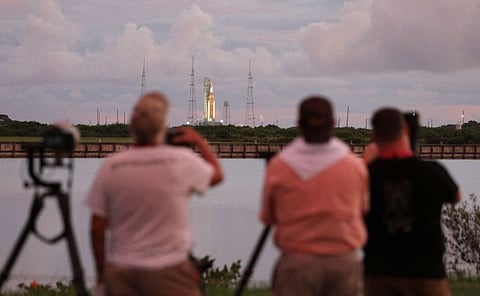Nasa says Friday launch of giant Moon rocket possible
Alternative dates for launch of Artemis 1 mission are Friday and Monday

Kennedy Space Center: A test flight of Nasa's powerful new Moon rocket may be possible on Friday, officials said, after the US space agency scrubbed Monday's launch because of an engine issue.
"Friday is definitely in play," Artemis 1 mission manager Mike Sarafin told reporters.
"They're still holding in the launch countdown configuration and we're preserving the option for Friday."
Alternative dates for launch of the Artemis 1 mission, an uncrewed flight around the Moon as part of an ambitious program to eventually go to Mars, are Friday and next Monday.
Blastoff had been planned for 8:33 am (1233 GMT) but was put on hold because of a temperature problem with one of the four engines on the 322-foot (98-meter) Space Launch System (SLS) rocket.
Tens of thousands of people - including US Vice President Kamala Harris - had gathered near the Kennedy Space Center in Florida to watch the launch, which comes 50 years after Apollo 17 astronauts last set foot on the Moon.
The goal of the flight is to test the SLS and Orion crew capsule that sits atop the rocket. Mannequins equipped with sensors are standing in for a crew for the mission.
Overnight operations to fill the orange-and-white rocket with more than three million liters of ultra-cold liquid hydrogen and oxygen were briefly delayed by a high risk of lightning.
Around 3:00 am, another hiccup emerged: a potential leak was detected during the filling of the main stage with hydrogen, causing a pause. After tests, the flow resumed.
But Nasa engineers later detected a problem with the temperature in one of the four RS-25 engines and put a hold on the countdown before eventually scrubbing the launch.
The rocket’s Orion capsule is to orbit the Moon to see if the vessel is safe for people in the near future. At some point, Artemis aims to put a woman and a person of color on the Moon for the first time.
“This mission goes with a lot of hopes and dreams of a lot of people,” Nasa Administrator Bill Nelson said.
Extreme temperaturesDuring the 42-day trip, the Orion capsule will orbit the Moon, coming within 60 miles (100 kilometers) at its closest approach, and then fire its engines to shoot out 40,000 miles - a record for a spacecraft rated to carry humans.
One of the mission’s primary objectives is to test the capsule’s heat shield, which at 16 feet in diameter is the largest ever built.
On its return to Earth’s atmosphere, the heat shield will have to withstand a speed of 25,000 miles per hour and a temperature of 5,000 degrees Fahrenheit (2,760 degrees Celsius) - roughly half as hot as the Sun.
The dummies aboard the spacecraft will record acceleration, vibration and radiation levels.
The craft will deploy small satellites to study the lunar surface.
A complete failure would be devastating for a program costing $4.1 billion per launch that is already years behind schedule.
Life on the Moon
The next mission, Artemis 2, will take astronauts into orbit around the Moon without landing on its surface. The crew of Artemis 3 is to land on the Moon in 2025 at the earliest.
And since humans have already visited the Moon, Artemis has its sights set on another lofty goal: a crewed mission to Mars.
The Artemis program is to establish a lasting human presence on the Moon with an orbiting space station known as Gateway and a base on the surface.
Gateway would serve as a staging and refueling station for a voyage to Mars that would take a minimum of several months.
Sign up for the Daily Briefing
Get the latest news and updates straight to your inbox



